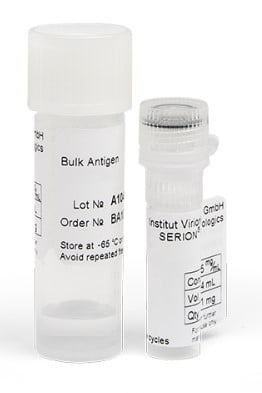| Weight | 1 lbs |
|---|---|
| Dimensions | 9 × 5 × 2 in |
| host | rabbit |
| isotype | IgG |
| clonality | polyclonal |
| concentration | 1 mg/mL |
| applications | ICC/IF, WB |
| reactivity | Rel (Phospho-Ser503) |
| available sizes | 100 µL |
rabbit anti-Rel (Phospho-Ser503) polyclonal antibody 5864
$366.00
Antibody summary
- Rabbit polyclonal to Rel (Phospho-Ser503)
- Suitable for: IF
- Isotype: Whole IgG
- 100 µl
rabbit anti-Rel (Phospho-Ser503) polyclonal antibody 5864
| antibody |
|---|
| Tested applications #VALUE! |
| Recommended dilutions Immunofluorescence: use at dilution of 1:100-1:200. These are recommended working dilutions. End user should determine optimal dilutions for their applications. |
| Immunogen Peptide sequence that includes phosphorylation site of Serine 503 (T-S-S(p)-D-S) derived from human Rel and conjugated to KLH. |
| Size and concentration 100µL and 1 mg/mL |
| Form liquid |
| Storage Instructions This antibody is stable for at least one (1) year at -20°C. |
| Storage buffer PBS (without Mg2 and Ca2 ), pH 7.4, 150mM NaCl, |
| Purity affinity purified |
| Clonality polyclonal |
| Isotype IgG |
| Compatible secondaries goat anti-rabbit IgG, H&L chain specific, peroxidase conjugated, conjugated polyclonal antibody 9512 goat anti-rabbit IgG, H&L chain specific, biotin conjugated polyclonal antibody 2079 goat anti-rabbit IgG, H&L chain specific, FITC conjugated polyclonal antibody 7863 goat anti-rabbit IgG, H&L chain specific, Cross Absorbed polyclonal antibody 2371 goat anti-rabbit IgG, H&L chain specific, biotin conjugated polyclonal antibody, crossabsorbed 1715 goat anti-rabbit IgG, H&L chain specific, FITC conjugated polyclonal antibody, crossabsorbed 1720 |
| Isotype control Rabbit polyclonal - Isotype Control |
| target relevance |
|---|
| Protein names Proto-oncogene c-Rel |
| Gene names REL,REL |
| Mass 68520Da |
| Function FUNCTION: Proto-oncogene that may play a role in differentiation and lymphopoiesis. NF-kappa-B is a pleiotropic transcription factor which is present in almost all cell types and is involved in many biological processed such as inflammation, immunity, differentiation, cell growth, tumorigenesis and apoptosis. NF-kappa-B is a homo- or heterodimeric complex formed by the Rel-like domain-containing proteins RELA/p65, RELB, NFKB1/p105, NFKB1/p50, REL and NFKB2/p52. The dimers bind at kappa-B sites in the DNA of their target genes and the individual dimers have distinct preferences for different kappa-B sites that they can bind with distinguishable affinity and specificity. Different dimer combinations act as transcriptional activators or repressors, respectively. NF-kappa-B is controlled by various mechanisms of post-translational modification and subcellular compartmentalization as well as by interactions with other cofactors or corepressors. NF-kappa-B complexes are held in the cytoplasm in an inactive state complexed with members of the NF-kappa-B inhibitor (I-kappa-B) family. In a conventional activation pathway, I-kappa-B is phosphorylated by I-kappa-B kinases (IKKs) in response to different activators, subsequently degraded thus liberating the active NF-kappa-B complex which translocates to the nucleus. The NF-kappa-B heterodimer RELA/p65-c-Rel is a transcriptional activator. |
| Subellular location SUBCELLULAR LOCATION: Nucleus {ECO:0000250}. |
| Structure SUBUNIT: Component of the NF-kappa-B p65-c-Rel complex. Component of the NF-kappa-B p50-c-Rel complex. Component of the NF-kappa-B p52-c-Rel complex. Homodimer; component of the NF-kappa-B c-Rel-c-Rel complex (By similarity). Interacts with NKIRAS1. Interacts with NFKBIB (By similarity). Interacts with NFKBIE. {ECO:0000250, ECO:0000269|PubMed:15024091, ECO:0000269|PubMed:15102766, ECO:0000269|PubMed:1740106, ECO:0000269|PubMed:8152812, ECO:0000269|PubMed:9056676, ECO:0000269|PubMed:9315679}. |
| Involvement in disease DISEASE: Immunodeficiency 92 (IMD92) [MIM:619652]: An autosomal recessive disorder characterized by recurrent bacterial, viral, fungal, or parasitic infections appearing in infancy or early childhood. Patient lymphocytes show defects in both T- and B-cell proliferation, cytokine secretion, and overall function, and there is also evidence of dysfunction of NK, certain antigen-presenting cells, and myeloid subsets. {ECO:0000269|PubMed:31103457, ECO:0000269|PubMed:34623332}. Note=The disease is caused by variants affecting the gene represented in this entry. |
| Target Relevance information above includes information from UniProt accession: Q04864 |
| The UniProt Consortium |
Data
| No results found |
Publications
Warning: Cannot modify header information - headers already sent by (output started at /www/benchmarkantibodiescom_769/public/wp-includes/script-loader.php:3015) in /www/benchmarkantibodiescom_769/public/wp-content/plugins/shortcode-manager/shortcode-manager.php(453) : eval()'d code on line 3
Publications
| pmid | title | authors | citation |
|---|---|---|---|
| We haven't added any publications to our database yet. | |||
Protocols
| relevant to this product |
|---|
| Western blot IHC ICC |
Documents
| # | SDS | Certificate | |
|---|---|---|---|
| Please enter your product and batch number here to retrieve product datasheet, SDS, and QC information. | |||
Only logged in customers who have purchased this product may leave a review.








Reviews
There are no reviews yet.